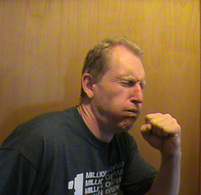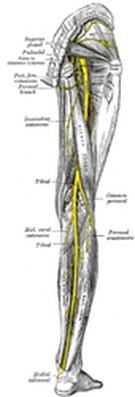Unlike most other doctors who do Spinal Decompression Therapy, I do not require an MRI. Although there are numerous reasons for this, the chief one is that between 50%-70% of the adult population of America has DISC HERNIATIONS that show up on the MRI ---- yet cause no back pain, SCIATICA, or other overt symptoms (HERE). Disc Bulges on MRI are an easy thing to point to as the cause of pain, when the reality is, it can be QUITE DIFFICULT TO TELL WHICH TISSUE IS CAUSING A PATIENT'S PAIN ---- frequently to the point of being impossible. So, what's a person to do if MRI cannot be trusted to deliver as accurate a result as you have been led to believe? How about a good Physical Examination and some inexpensive x-rays?
Although spinal x-rays cannot show us Disc Herniations, they do a fabulous job of showing DISC DEGENERATION (sometimes called "Spondylosis"). However, there are some very basic Examination Findings that provide a big clue as to whether or not a person is dealing with a Disc Problem. Although there are all sorts of Neurological and Orthopedic tests that can provide some valuable clues, there are three chief signs that your problem is likely disc-related. If you have all three, you can be pretty sure that you are dealing with at least some degree of DISC RUPTURE.
THE "BIG THREE" SIGNS
- ANTALGIA: An antalgic posture is being pulled to one side or the other (or to the front). If the disc's jelly center (Nucleus Pulposus) "slips" or herniates to the right, most of the time people will lean to the left and vise versa. This is an automatic reaction of the body as it tries to pull you off of, or away from the disc bulge. Often times you will notice that the belly button is pulled away from the body's center line.
- POSITIVE VALSALVA or DeJARINE SIGN: This is pain when you cough, sneeze, or strain on the stool. When you cough or sneeze, you develop a great deal of momentary internal pressure. Because force always takes the path of least resistance, the pressure released by a cough or sneeze pushes on the bulged portion of the disc. I frequently hear people tell me that if they know they are going to cough or sneeze, they hold themselves up in a counter or table so their legs do not collapse out from under them in sheer pain. Speaking of legs......
- SCIATICA: The nerves from either side of your low back area grow together into one nerve ---- the Sciatic Nerve. The Sciatic Nerve is not only the longest nerve in the body, it is the biggest as well. If you cause pressure on one of the nerves that makes up the Sciatic Nerve, you can end up in a world of hurt. This can be in the form of pain. But it can also be in the form of numbness, tingling, weakness, odd sensations (paresthesia), etc. Sometimes the pain will do odd things like start at the knee and go down, or skip certain areas. Sciatica can also mimic knee or hip problems as well.
ANTALGIA Disc Bulges cause pressure on nerves that automatically pull you away from the pain into an "antalgic" position. You have no control over this. | VALSALVA ABOVE: Pressure generated by coughing or sneezing causes pressure on Herniated Discs that can cause paralyzing pain. RIGHT: When injured or degenerative lumbar discs press on nerves, you will get symptoms in the leg(s). | SCIATICA |
If you might be wondering whether or not Spinal Decompression Therapy might be the solution for you, please call us at (417) 934-6337 to set up a free, no-obligation, consultation with Doctor Schierling. Not everyone is a GOOD CANDIDATE for Spinal Decompression Therapy. If he thinks that you can be helped, he will tell you so. If not, he will tell you that also.






 RSS Feed
RSS Feed
